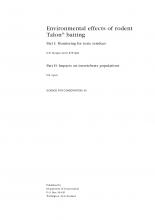Environmental effects of rodent Talon baiting Part I : Monitoring for toxic residues : Part II Impacts on invertebrate populations

BRB
Available Online
Morgan, D. R.
,
Spurr, E. B.
,
Wright, G. R.
1998
Although Talon® baits containing brodifacoum have been used successfully in eradicating rats from some of New Zealands offshore islands, little is known about any environmental effects of this toxin. We sampled invertebrates, blackbirds, soil, and water at intervals of 2 days to 9 months to determine whether brodifacoum residues were present after aerial distribution of Talon® 20P cereal pellets on Red Mercury Island and after bait-station use of Talon® 50WB wax-coated cereal blocks on Coppermine Island. No brodifacoum residues were found in soil, water, or most (99%) invertebrate samples. Low to moderate residues were found in one sample of slugs collected 2 days after aerial sowing. Tissues from all birds (n=4) and rats (n=3) found dead and livers from all six birds collected alive 8 months after aerial baiting also contained low to moderate residues. These preliminary results suggest that few invertebrates are likely to be contaminated as a result of Talon® baiting. Tentatively, we suggest that although some invertebrates may eat Talon® baits, it appears that the brodifacoum is either metabolised and/or excreted within a few days. The dead blackbirds found, therefore, were more likely to have been killed by primary than by secondary poisoning. Further monitoring for brodifacoum residues after Talon® operations should be undertaken to confirm that contamination of invertebrates, soil, and water is unlikely. Some bird species may be at risk from Talon® baiting. Likely effects on population levels of such species should be considered to help assess the risk and benefits of Talon® use in rodent eradication.



